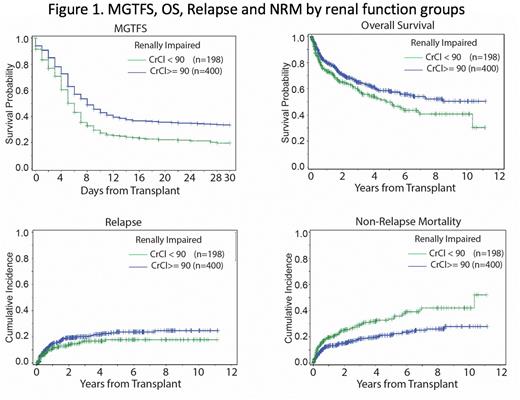Abstract
Melphalan is commonly used for reduced-intensity conditioning (RIC) for allogeneic hematopoietic cell transplant (HCT) in older patients and those with comorbidities. Renal impairment is a significant comorbidity in older patients and has been associated with increased incidence and severity of mucositis, gastrointestinal (GI) toxicities and prolonged time to engraftment in patients receiving melphalan conditioning for autologous HCT (BMT 2006, 38(7):501-6; BMT 2016, 51:1337-41). However, there is limited data assessing the impact of renal function on melphalan-based RIC HCT. This retrospective study aims to evaluate the impact of renal dysfunction on melphalan-based RIC HCT outcomes and regimen-related toxicities and morbidities.
Patients aged 55-75 years old who underwent first peripheral blood stem cell (PBSC) RIC HCT with fludarabine and melphalan (FM) at City of Hope between July 2009 and December 2019 were reviewed. All patients received tacrolimus and sirolimus as graft-versus-host disease (GvHD) prophylaxis. FM RIC consisted of fludarabine 125 mg/m2 with melphalan 100 mg/m2 (FM100; n=37) or 140 mg/m2 (FM140; n=561).
All patients underwent baseline organ function testing within 30 days prior to starting RIC and were divided into two groups based on pre-HCT creatinine clearance (CrCl) measured by 24-hour urine collection according to chronic kidney disease (CKD) staging from the National Kidney Foundation (NKF): <90 ml/min (CKD 2-3, n=198) and ≥ 90 ml/min (CKD 0-1, n=400). No patients had CrCl <30 ml/min. For comparison, renal function was also calculated by the CKD Epidemiology Collaboration (CKD-EPI) equation and the Cockroft-Gault (CG) formula (mL/min). A novel composite endpoint of melphalan-induced severe GvHD- and GI toxicity- free survival (MGTFS) was used and included the cumulative incidence of grade 3-4 acute GvHD; grade 3-4 diarrhea, nausea/vomiting, and mucositis; and death from day 0 to 30. All laboratory abnormalities and adverse events (AEs) were graded using CTCAE version 5.0. AEs were deemed conditioning-related if they started between melphalan administration and engraftment.
Descriptive statistics were used to summarize patient demographic, disease, treatment characteristics and AE data. Survival estimates were calculated using the Kaplan-Meier method and differences were examined by the log-rank test. The cumulative incidence of relapse/progression and non-relapse mortality (NRM) were calculated using competing risk analysis and differences were examined by Gray's test.
All patients (n=598) met institutional criteria for pre-HCT liver function assessment, and 98% of patients met cardiac assessment criteria (EF >50%). Median age at HCT was 64 years (range: 55-74) and 57% of patients were male. Donors were HLA-matched sibling (42%) or unrelated (58%). The most common diagnoses were AML (44%), MPN/MDS (37%) and ALL (12%). With median follow up of 48 (range: 11.7-134.2) months among surviving patients, renal impairment measured by 24-hour urine collection was associated with significantly higher 4-year NRM (CKD 2-3=32%, CKD 0-1=20%; p<0.01) and lower 4-year overall survival (OS) (CKD 2-3=54%, CKD 0-1=61%; p=0.03) (Figure 1). CrCl calculated by CKD-EPI and CG were not predictive of NRM or OS. No renal function indicators impacted relapse rates.
Incidence of oral mucositis was significantly higher in patients with CKD 2-3 versus CKD 0-1 (67% vs 53%; p<0.01). Compared with CKD 0-1 patients, parenteral nutrition use was both significantly higher in CKD 2-3 patients (77% vs 66%; p<0.01) and significantly longer (median 21 days vs 18 days; p<0.01). Patients with CKD 2-3 had significantly lower MGTFS compared to patients with CKD 0-1 (19% vs 32%; p<0.01) (Figure 1). Melphalan dose negatively impacted MGTFS on univariate analysis, but this was not significant when adjusted for 24-hour measured CrCl, HCT era and donor/recipient gender.
Of the methods used to assess renal function, only CrCl measured by 24-hour urine collection correlated with long term NRM and OS after FM RIC HCT. Overall, for patients undergoing HCT with FM RIC, baseline renal impairment was associated with lower MGTFS, a newly proposed composite endpoint, indicating higher morbidity and mortality in the first 30 days. Lower melphalan dose in this setting does not seem to overcome this adverse outcome and the benefit of higher intensity regimens should be balanced with risk of disease relapse.
Disclosures
Ball:Oncovalent: Membership on an entity's Board of Directors or advisory committees. Koller:Takeda: Speakers Bureau; Treadwell Therapeutics: Other: Safety Review Committee; Novartis: Consultancy, Membership on an entity's Board of Directors or advisory committees, Speakers Bureau. Artz:Abbvie: Honoraria; Magenta: Honoraria. Salhotra:Orca Bio: Research Funding; BMS: Research Funding; Kadmon: Other: Advisory board meeting . Aldoss:Jazz Pharmaceuticals: Honoraria, Speakers Bureau; Autolus Limited: Consultancy; Amgen: Consultancy; Agios: Consultancy, Honoraria; AbbVie: Consultancy, Research Funding; Kite: Consultancy. Pullarkat:AbbVie, Amgen, Genentech, Jazz Pharmaceuticals, Novartis, Pfizer, and Servier: Membership on an entity's Board of Directors or advisory committees, Speakers Bureau; Amgen, Dova, and Novartis: Consultancy, Other: Advisory Board Member. Ali:Bristol Myers Squibb: Membership on an entity's Board of Directors or advisory committees; Incyte Corporation: Membership on an entity's Board of Directors or advisory committees, Speakers Bureau; Abbvie: Membership on an entity's Board of Directors or advisory committees. Stein:Amgen: Honoraria. Marcucci:Lynx: Membership on an entity's Board of Directors or advisory committees; Abbvie: Other: Speaker and advisory scientific board meetings. Nakamura:BluebirdBio: Consultancy; Omeros: Consultancy; Sanofi: Consultancy; Magenta Therapeutics: Consultancy; Kadmon: Consultancy; Helocyte Inc: Research Funding.
Author notes
Asterisk with author names denotes non-ASH members.


This feature is available to Subscribers Only
Sign In or Create an Account Close Modal